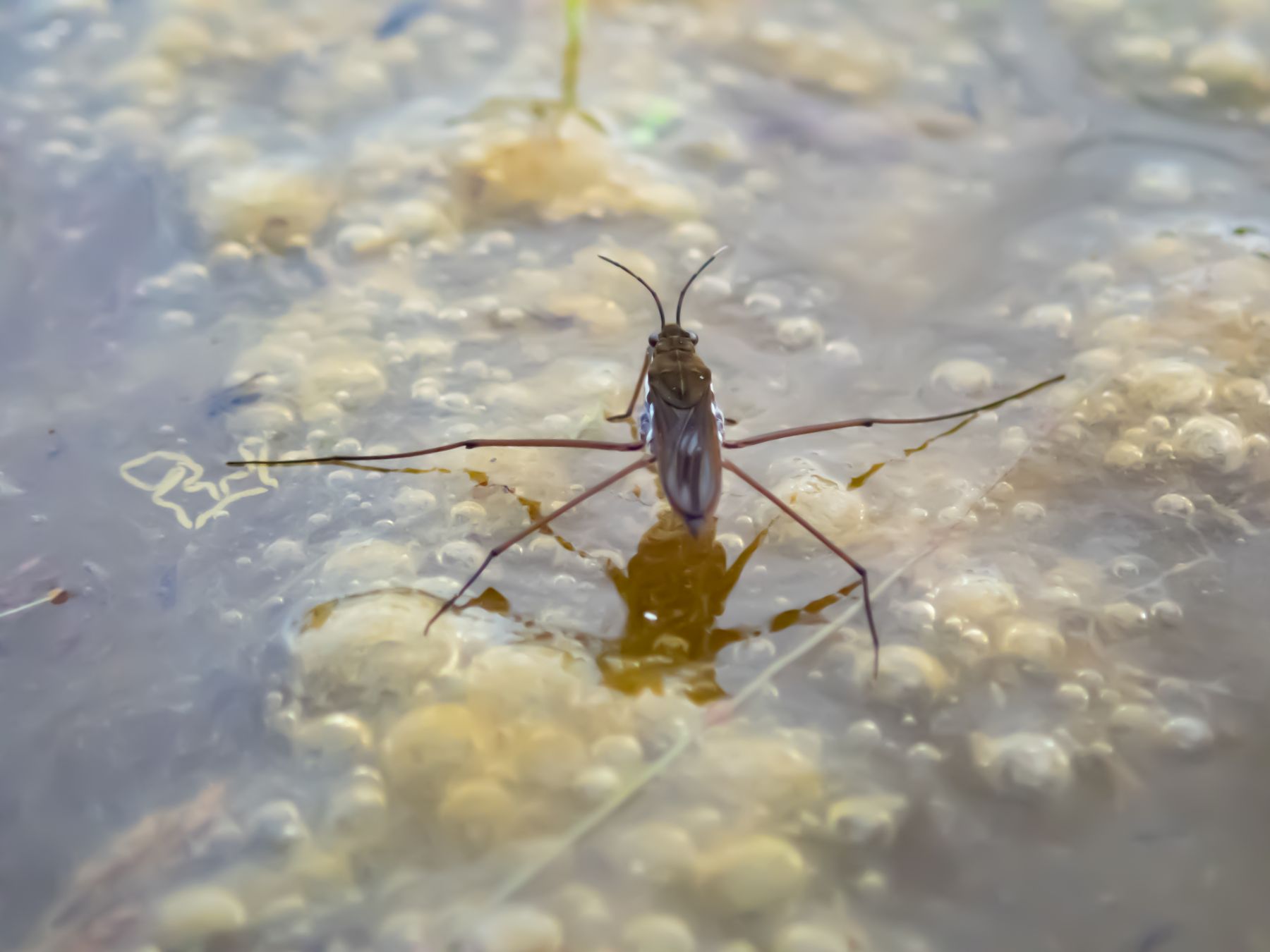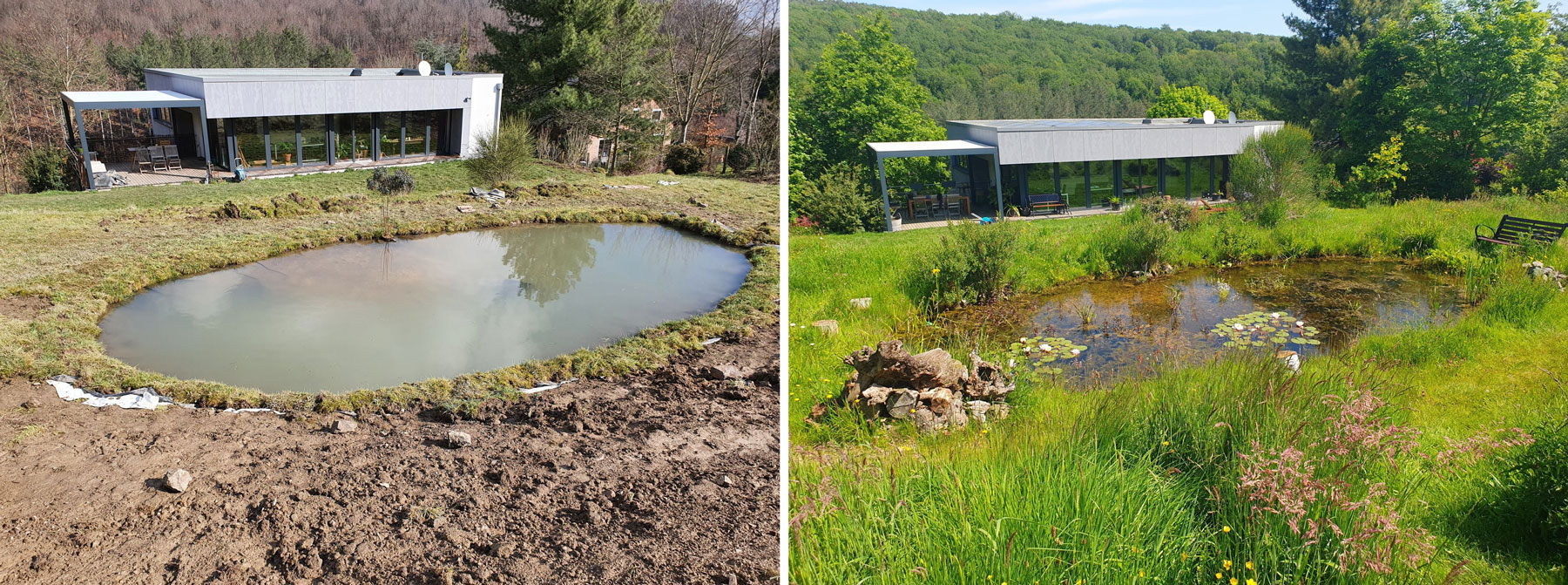

.jpg)


Pond fun
14/03/2024
Without a doubt, our pond is my favourite spot in the garden. I revived an old wooden cast-iron garden bench and that is where I go to chill, muse, read, and above all, observe all that goes on in, on and around the water. It still exceeds my expectations.
The creation of our pond is, by far, the intervention in our garden that made the species counter soar. It takes a while for the vegetation to take hold and a few years for a good balance to be established in the pond, but fortunately that doesn't stop the animals. They seem to smell, see and feel the water from a great distance ...
In March 2020, we created our pond. When it had just been filled, a pair of mallards already landed there, prospecting for a nesting place. We planted oxygenating plants, riparian plants, yellow iris, marsh marigold, brookpunge and many others at three different depths. Before long, backswimmers, common whirligig beetles, water striders, snails and numerous mini organisms were lining up to take up residence.

Of course, not everyone has the space for it, but if you do, consider a natural pond to give your ecological garden a real boost. The pond should be installed in the lower part of your garden so that water automatically flows into it. It should be in full sun with different depths and zones where you plant a diversity of native aquatic plants. With the current dry summers, it is best to have a depth of 1.20-1.40 metres. Depending on your soil, you might need to place an epdm pond liner to keep it watertight. Also, be sure to avoid leaf fall from the trees, as this requires more maintenance. Around the pond, it is best to have some spots with longer vegetation so that animals can easily find shelter. We also placed a wood and stone pile next to it. When filling the pond, it is best to use a mix of rainwater and tap water. In a natural pond, amphibians get priority over fish!
Water gives life and brings tranquility. One of the perks is the beautiful play of light due to the reflection of cloud cover, sunset, and vegetation on the water surface. This provides beautiful scenes especially in the early and late hours of the day. Enjoy!
If you are interested in your own (mini) pond and would like more concrete information on how best to go about it, be sure to contact us.
The creation of our pond is, by far, the intervention in our garden that made the species counter soar. It takes a while for the vegetation to take hold and a few years for a good balance to be established in the pond, but fortunately that doesn't stop the animals. They seem to smell, see and feel the water from a great distance ...
In March 2020, we created our pond. When it had just been filled, a pair of mallards already landed there, prospecting for a nesting place. We planted oxygenating plants, riparian plants, yellow iris, marsh marigold, brookpunge and many others at three different depths. Before long, backswimmers, common whirligig beetles, water striders, snails and numerous mini organisms were lining up to take up residence.

Who spread the news is not yet entirely clear to me, but what a hopeful scenario. You create the right conditions and nature does the rest. Meanwhile, our list of residents includes several dragonfly species, damselflies, 3 species of newts, and common frog. Our highlight was the visit of a grass snake and the following year I even saw two juveniles. The pond is a living, nesting, eating and drinking place, it has something for everyone. In summer, you can observe the swallows drinking in the morning, the heron comes by for a snack a little later, many insects seek cooling and at night the bats hunt there. A natural pond is a true biodiversity magnet. Thanks to this diversity, we do not have any problems with mosquitoes, which many often fear.
Of course, not everyone has the space for it, but if you do, consider a natural pond to give your ecological garden a real boost. The pond should be installed in the lower part of your garden so that water automatically flows into it. It should be in full sun with different depths and zones where you plant a diversity of native aquatic plants. With the current dry summers, it is best to have a depth of 1.20-1.40 metres. Depending on your soil, you might need to place an epdm pond liner to keep it watertight. Also, be sure to avoid leaf fall from the trees, as this requires more maintenance. Around the pond, it is best to have some spots with longer vegetation so that animals can easily find shelter. We also placed a wood and stone pile next to it. When filling the pond, it is best to use a mix of rainwater and tap water. In a natural pond, amphibians get priority over fish!
Water gives life and brings tranquility. One of the perks is the beautiful play of light due to the reflection of cloud cover, sunset, and vegetation on the water surface. This provides beautiful scenes especially in the early and late hours of the day. Enjoy!
If you are interested in your own (mini) pond and would like more concrete information on how best to go about it, be sure to contact us.
Comments
- Inderdaad prachtige plek om te verpozen, we kunnen zeker bevestigen dat onze poel/vijver combinatie ongelooflijk veel leven en bio-activiteit brengt in onze tuin. Variëteit en leven dat nooit verveelt en heerlijk om van te genieten. (Johan)
Add a comment


